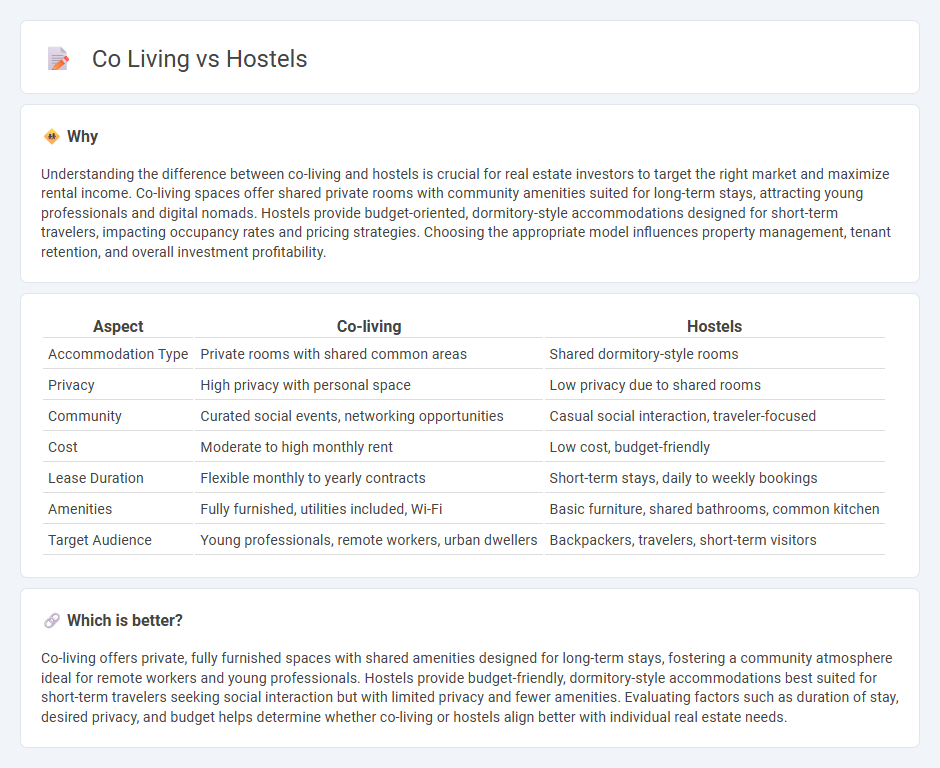
Co-living spaces offer private bedrooms combined with shared common areas, promoting community and flexibility, while hostels primarily provide budget accommodation with dormitory-style rooms catering to short-term stays. Real estate trends indicate a growing preference for co-living among young professionals seeking more comfortable, social living environments versus traditional hostels favored by travelers. Explore deeper insights on how co-living is transforming urban housing markets today.
Why it is important
Understanding the difference between co-living and hostels is crucial for real estate investors to target the right market and maximize rental income. Co-living spaces offer shared private rooms with community amenities suited for long-term stays, attracting young professionals and digital nomads. Hostels provide budget-oriented, dormitory-style accommodations designed for short-term travelers, impacting occupancy rates and pricing strategies. Choosing the appropriate model influences property management, tenant retention, and overall investment profitability.
Comparison Table
| Aspect | Co-living | Hostels |
|---|---|---|
| Accommodation Type | Private rooms with shared common areas | Shared dormitory-style rooms |
| Privacy | High privacy with personal space | Low privacy due to shared rooms |
| Community | Curated social events, networking opportunities | Casual social interaction, traveler-focused |
| Cost | Moderate to high monthly rent | Low cost, budget-friendly |
| Lease Duration | Flexible monthly to yearly contracts | Short-term stays, daily to weekly bookings |
| Amenities | Fully furnished, utilities included, Wi-Fi | Basic furniture, shared bathrooms, common kitchen |
| Target Audience | Young professionals, remote workers, urban dwellers | Backpackers, travelers, short-term visitors |
Which is better?
Co-living offers private, fully furnished spaces with shared amenities designed for long-term stays, fostering a community atmosphere ideal for remote workers and young professionals. Hostels provide budget-friendly, dormitory-style accommodations best suited for short-term travelers seeking social interaction but with limited privacy and fewer amenities. Evaluating factors such as duration of stay, desired privacy, and budget helps determine whether co-living or hostels align better with individual real estate needs.
Connection
Co-living and hostels are interconnected by their focus on affordable, communal living spaces designed for social interaction and convenience in urban environments. Both models optimize real estate by maximizing occupancy through shared amenities and flexible leasing options, catering to transient residents such as students, young professionals, and digital nomads. The rise of co-living spaces reflects a growing demand for affordable housing solutions that blend the social aspects of hostel living with long-term accommodation stability.
Key Terms
Shared Amenities
Hostels provide shared amenities such as communal kitchens, lounges, and laundry facilities designed to accommodate transient guests seeking affordable, short-term stays. Co-living spaces offer enhanced shared amenities including coworking areas, fitness centers, community events, and private rooms alongside common zones, catering to individuals looking for longer-term communal living experiences. Explore the differences in shared amenities between hostels and co-living to choose the ideal living arrangement.
Lease Structure
Hostels typically offer short-term, flexible lease structures ideal for travelers or temporary stays, often requiring daily or weekly payments without long-term commitments. Co-living spaces, on the other hand, provide medium to long-term leases with fixed monthly rents, fostering community living and stability for digital nomads or professionals. Explore detailed comparisons to find the best lease arrangement suited to your lifestyle needs.
Community Engagement
Hostels foster community engagement through shared spaces and group activities designed for short-term travelers seeking social interaction. Co-living spaces enhance community bonds by offering longer-term residents collaborative environments with organized events, shared responsibilities, and networking opportunities. Explore how these distinct living arrangements build meaningful connections to suit your lifestyle.
Shared Amenities
Hostels typically offer shared amenities such as communal kitchens, lounges, and laundry facilities designed for short-term travelers, fostering social interaction in vibrant environments. Co-living spaces provide similar shared amenities but emphasize long-term comfort with features like private workspaces, wellness areas, and curated community events for residents. Explore the detailed comparison to find the best shared amenities suited to your lifestyle preferences.
Lease Structure
Hostels typically operate on a short-term lease structure, often offering flexible, daily or weekly rates with shared accommodations and minimal contractual obligations. Co-living spaces provide longer-term leases, usually spanning several months, combining private bedrooms with communal living areas and amenities, fostering a community-oriented environment. Explore the differences in lease structures to determine which living arrangement suits your lifestyle and stability needs best.
Community Engagement
Hostels foster vibrant community engagement through shared spaces and organized social activities, promoting interaction among travelers from diverse backgrounds. Co-living spaces emphasize deeper community bonds with long-term residents collaborating on events, workshops, and shared responsibilities, creating a more integrated living experience. Explore how these housing options enhance social connections and community involvement to find the best fit for your lifestyle.
Source and External Links
Hostel - A hostel is a form of low-cost, short-term shared sociable lodging where guests can rent beds in dormitories and enjoy shared facilities like kitchens and lounges.
Hostels in Los Angeles - Los Angeles hostels offer affordable accommodations with prices starting from $23 per night, often located in vibrant areas like Hollywood and Venice Beach.
Hostels in Los Angeles - Hostelz provides a platform to compare prices for hostels in Los Angeles, with dorm beds averaging $11 per night and private rooms around $72.
 dowidth.com
dowidth.com